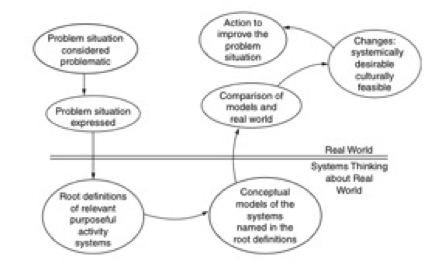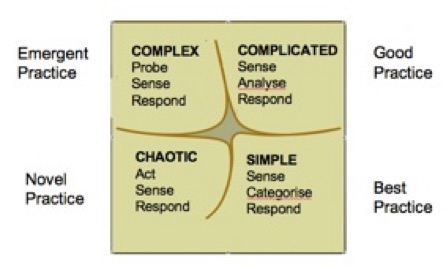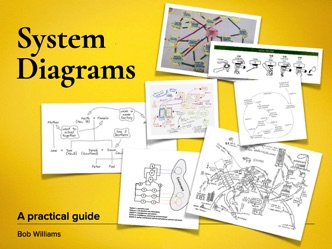Here are some of the nice things that people have said about our book :
"The book promises and delivers: tested and practical methods for understanding and taking action in messy situations; inquiry approaches for describing, analysing, learning about, managing, and changing complex situations; a coherent systems framework for thinking and acting systemically. The authors compare 19 systems approaches, and do so comprehensively, insightfully, exquisitely."
—Michael Quinn Patton, author of Developmental Evaluation: Applying Complexity Concepts to Enhance Innovation and Use
"This book presents well-written and accessible accounts of a variety of systems methods, methodologies, and models; a veritable treasure-trove from which the critical systems thinker can choose in constructing appropriate systemic responses to complex situations."
—Michael C. Jackson, Hull University Business School
"This book is written for those who want to intervene in the world, but are aware that brute force methods often prove inappropriate—if not counterproductive. Systems Concepts in Action provides a toolbox of methods for harnessing systemic thinking to instigate custom tailored, creative solutions. If you ever felt that systems theory is abstract and non-instructive, then have a read!"
—Wolfgang Hofkirchner, President, Bertalanffy Center for the Study of Systems Science, Vienna
"The book demonstrates convincingly that systems approaches to evaluation are more than 'spaghetti diagram' logic models. With clear introductions to many different approaches, and how they can be used for evaluation, it will be indispensable for evaluators and evaluation commissioners. It's bound to become dog-eared and shabby on my book shelf." —Patricia Rogers, Royal Melbourne Institute of Technology
"This book stands out as an invaluable, fresh, and practical guide to the use of systems concepts from two internationally recognised practitioners."
—Martin Reynolds, The Open University
PROSAIC OR PROFOUND; THE ADOPTION OF SYSTEMS IDEAS IN IMPACT EVALUATION
One thing that frustrates me above everything else is when people use words from the systems field without actually using the ideas that underpin those words. When you start getting in touch with the ideas, everything changes. You just cannot deal with the world in the same way; the consequences are profound rather than prosaic. On the whole, evaluation has grabbed the words and not really confronted the reality of applying the ideas. Partly this is because the use of systems ideas challenge and undermine the way in which evaluation is commonly practiced. A few years ago I was asked to give a keynote speech at an evaluation conference where I explored what I felt were the potential consequences for evaluation practice of the application of systems ideas. The presentation was later published in a modified form by the Bulletin of IDS (the Institute for Development Studies at the University of Sussex in the UK).
I need to say that the paper was hated by the Bulletin reviewers. To their credit the editors allowed the paper to be published with relatively minor changes.
In our above book, Richard and I suggest that a systemic inquiry can be informed by posing a dozen or so questions grouped according to three concepts; inter-relationships, perspectives and boundaries. This heuristic steps you through these questions in an appropriate sequence. The heuristic is still in development so comments welcome.
SYSTEMS CONCEPTS IN EVALUATION - An Expert Anthology
Predating the Systems Concepts in Action book by three years, this volume was the first systems publication to focus exclusively on evaluation. It draws on a wide range of systems traditions -
- the "hard" systems of cybernetics and system dynamics
- "soft systems"
- "critical systems"
- "complex systems"
... as well as several others.
Each chapter comes with an evaluation case study and a method, plus some methodological discussion. It was edited by myself and the late Iraj Imam for the American Evaluation Association with a grant from the WK Kellogg Foundation.
The full details can be viewed here
Williams B. Imam I. (2007) Systems Concepts in Evaluation - An Expert Anthology EdgePress/AEA Point Reyes CA.
ISBN 978-0-918528-22-3 softbound, and 978-0-918528-21-6 hardbound
Copies can be ordered via Amazon
THE FUNDAMENTALS OF SYSTEMS THINKING
During the development of the above publication, most of the authors got together in Berkeley, California to discuss what everyone had in common. The idea was to write the opening chapter, but things got a bit bigger than that. In the end we came to the conclusion that despite the huge diversity of methods, methodologies and notions floating around the systems field, three things glued us all together: a deep interest and orientation around inter-relationships, perspectives and boundaries. This document provides an introduction to those ideas and links them to various systems methods. Since evaluators are primarily interested in questions, I've linked each element and method to a set of evaluation style questions. So if you are attracted to Question X, use systems approach Y.
This particular document was prepared for a symposium - Navigating Complexity - organised by Wageningen University in the Netherlands. My thanks to Jim Woodhill and Irene Guijt for making that possible.
Various writings spun off this text including an article in Capacity.org called "Thinking Systemically" that is, in my view, a useful companion piece. Their website doesn't appear to be working at the moment but hopefully in the future you can access it here.
BEYOND LOGFRAME : USING SYSTEMS CONCEPTS IN EVALUATION
In December 2009, Patricia Rogers and I held a series of workshops for the Foundation for Advanced Studies in International Development (FASID) in Japan. FASID researches the effectiveness of Japanese international development projects. This publication emerged out of these workshops and reflects the state of my current thinking about the role of systems ideas in evaluation. The publication contains three key articles.
The first is a paper by Richard Hummelbrunner that looks at systemic alternatives to LogFrame. Richard is currently helping the German international development agency (GTZ) replace LogFrame as their key management and evaluation tool.
The second is an expanded version of the Capacity.org paper mentioned above. It goes into much greater detail about the specific contribution of systems methods to capacity development.
The third is a "constructed" conversation between FASID staff, Patricia Rogers and myself about the potential for systems ideas in evaluation, and some of our experience (both good and bad) in applying them. I especially like this piece because it is more reflective than promotional.
CULTURAL-HISTORICAL ACTIVITY SYSTEMS (CHAT)
This is heady stuff, but alongside Argyris and Schon's Action Science, Churchman’s Critical Systems and Checkland's Soft Systems, CHAT probably forms the foundations of my professional practice.
Activity Systems theory (or more accurately Cultural-Historical Activity Theory) is really an attempt to merge systems, Vygotskyian based learning, and action research theories. Plus a bit more. I think it is an astonishingly powerful tool for understanding what is going on in a system, and how to help shape events. It was developed primarily by Yrjo Engestrom at the Centre for Research on Activity, Developmental and Learning (CRADLE) Yrjo Engestrin Helsinki , and adopted by my colleages at WEB Research here in New Zealand.
Peter Checkland's Soft Systems Methodology (SSM) is one of the most important (and possibly most misunderstood) systems approaches. Even Checkland himself acknowledges it took him the best part of twenty years to discover its most powerful role - as a learning tool rather than a modelling or planning tool.
It's one of those simple frameworks that looks easy but can be very demanding in practice. And so it should be if it is to get the kind of insights that it was designed to promote.
This version is the basis of a workshop I run on SSM. It started off life as a workshop at the Australasian Evaluation Society and American Evaluation Association Conferences, but much improved thanks to the interest of the the W.K. Kellogg Foundation.
I've also posted an alternative workshop form developed by Bob Dick, which provides an insightful and refreshing way of understanding SSM. I've altered it based on my own experience. This workshop is a lot of fun and a very useful way for people to learn about Soft Systems Methodology. It is best used on a real life issues, which further adds to the pleasure. There’s a much more comprehensive account of the methodology in the Systems Concepts in Action book.
The idea of holism in systems approaches misleads us into thinking we can look at everything. But that is an absurd notion - we can't consider everything neither in theory (as complexity science tells us) nor in practice (as just about everything else tells us). So we have to draw boundaries.
So by the early 1980’s questions were being raised about the ethical dimension of drawing boundaries, in particular C West Churchman. He argued that at a practical and theoretical level we had to think of the consequences of the boundaries we draw. His seminal book "The Systems Approach and its Enemies argued that you always had to look at both sides of the boundaries - and consider redrawing boundaries to ensure that those you eventually drew were based on sound ethical principles. Google did not invent the idea of "do no harm". Somewhat later the German planner Werner Ulrich produced an heuristic that provides a practical way of implementing Churchman's ideas. Critical Systems concepts have had a profound impact on my thinking and practice as an evaluator, since criteria and values both delineate boundaries. I firmly believe that critical systems ideas could drive evaluation into territory it needs to go but is reluctant to do so.
This short paper is based on a workshop developed with Martin Reynolds of the Open University Systems Group for the American Evaluation Association. There is a more extensive and clearer version in the Systems Concepts in Action book.
Also check out this half hour video that introduces Critical Systems Heuristics. This was a talk I gave to the Centre for Evaluation of Complexity across the Nexus (CECAN) network. https://youtu.be/87pD2gjrcUs


For me, systems concepts provide me with very powerful ways of exploring inter-relationships, perspectives and boundaries. These are important issues within evaluation.
•Inter-relationships are the key to understanding how programs behave.
•Perspectives provide insight into motivations and thus how people behave.
•Boundaries determine who wins and who loses from an intervention, or what is "in" and what is "out" of an assessment of that intervention. In other words boundaries indicate judgements of value or worth.
More than evaluation, the systems field has thought deeply about these three concepts and come up with approaches that can transform the way in which evaluation does its job.
The material in this section indicates what is possible and how people have used systems concepts in evaluation.
I'm indebted to many people in developing this work. They are far too many to list here and all played vital roles. I stand on the shoulder of giants. What follows is as much to do with them as me - although all the mistakes are mine. Much of the other material emerged from workshops for local and national evaluation associations, various multilateral agencies and way way back the W.K. Kellogg Foundation and I thank them for their support.
SYSTEMS DIAGRAMS - A PRACTICAL GUIDE
The past few years has seen increased use of system diagrams in evaluation and by evaluation clients. System diagrams provide an excellent way of clarifying complex situations and help to address identified problems. Potential users are not spoilt for choice - there are literally dozens of different diagram-based approaches.
On the other hand, there are not many easily accessible publications that describe how to match and show how to use appropriate diagrams to particular tasks. That's why System Diagrams; A Practical Guide came to be written.
SYSTEM DIAGRAMS; A PRACTICAL GUIDE ebook covers six widely used diagram approaches that between them cover a range of potential uses by evaluators;
Rich Picturing. Useful when trying to get to grips with the complexity of a situation and work out which aspects you should be focusing on.
Influence Diagrams. Useful when you want to have a snapshot of what is influencing a particular issue or topic at a particular moment in time.
Causal Diagrams. Useful when you want to explore the possible consequences of specific causal relationships within a particular issue or topic over a period of time.
Cynefin. A diagram based approach that helps you to think about and respond to a particular situation, or intervention, through five different framings; simple, complicated, complex, chaotic and confused.
Viable System Model (VSM). A diagram based approach that helps to assess and ensure the viability of a purposeful activity, given the range of
competing demands from different components of that endeavour.
Cultural Historical Activity System Model (CHAT). A diagram based approach that explores a series of factors that enable people with different motivations to work together creatively and effectively, especially when responding to changing and challenging events.
The discussion of each approach is accompanied by a worked example and a set of questions that that the diagram addresses. There are also chapters on the role of diagrams in general; what constitutes a systemic inquiry and the overall nature of system diagrams.
The ebook is free with an optional donation to cover production costs.
It can be downloaded in pdf and ebook formats from http://gum.co/systemdiagrams
OBTAIN A COPY HERE
View a video introduction here
Evaluation is about making judgments of worth.
Design is a process that narrows things down from an infinite number of judgments of worth, to those that really matter. It decides 'matters to whom' and in what circumstances. It decides what methods we have to use to know who benefits and who doesn't.
The interventions that evaluation investigates are complex, with many different perspectives on what is worthwhile and what is not. Evaluations are about values. Evaluation treads on people's dreams. So these are not easy decisions.
Evaluators have an obligation to be well informed; to understand the situation, the intervention, its context and to understand the evaluation and the likely consequences. This is both an evaluation design issue and also an evaluation management issue.
Systems thinking has a long history in design and management of interventions like evaluation.
In particular systems concepts help you;
· determine the purposes of both the intervention to be evaluated and the evaluation
· understand the potential and desirable uses, influence and consequences of the evaluation
· elicit the criteria by which evaluative judgements of merit, value or worth
· identify the key evaluation questions that will enable these judgments
The workbook Systemic Evaluation Design brings that experience to evaluation.
Systemic Evaluation Design is a workbook that takes you through the design process from soup to nuts. It helps you understand more deeply both the intervention and the evaluation. It also recognises that 'design' is a process that occurs throughout the evaluation and beyond. It's not just something you do at the beginning. So it is about effective evaluation management as much as one-off design
It's a workbook not a text book, so specifically designed to help you design your evaluation.
In English it is available as an ebook here.
In Spanish, thanks to the work of Alain Santandreu of ECOSAD, and Brenda Bucheli of Pontificia Universidad Católica del Perú (PUCP) and EvalPeru, you can get a free copy of the first edition from here. ECOSAD also sell a beautifully produced hardcopy version.
WICKED SOLUTIONS : A SYSTEMS APPROACH TO COMPLEX PROBLEMS
This book, written with Sjon van ‘t Hof, is about the use of core systems ideas in dealing with wicked situations. Wicked situations are those where identifying problems is not easy and selecting good solutions is even more difficult. Many societal, business and development challenges are in fact wicked problems.
Using three basic systems concepts – inter-relationships, perspectives, and boundaries - this book will help you :
■unpick the tangle of issues that need addressing
■design suitable ways of tackling those issues
■deal with some tricky aspects of working in wicked situations
■find more information about systems methods and managing interventions systemically.
A free, 24-page partial preview can be downloaded from here
You can get an ebook version here
And a physical book here
The Research Institute for Humanity and Nature (RIHN) in Kyoto, Japan is a remarkable institution dedicated to the transdisciplinarly study and resolution of problems resulting from humanity's interaction with nature. On the ground floor it has all the fancy scientific equipment you could imagine, and on the floor above multi-disciplinary teams working on complex socio-political-scientific issues.
For each project, the teams have a year to come up with a design. If that design is considered adequate then they have three years to implement that design. So clearly design is an important element of their work - but how to you design an intervention in highly complex environments using multiple knowledge systems (scientific, indigenous, political)?
I've had a working relationship with RIHN for a while and given my interest in design ran a two day workshop based on Wicked Solutions and emerging ideas that became Using Systems Concepts in Evaluation Design (although in this case oriented towards research design). Participants worked on their own projects throughout the two days.
The workshop was recorded and brilliantly edited into two separate videos; one exploring the basic principles and the other covering the more detailed aspects of research design using systems ideas. The two videos ended up as one of iTunes top ten scientific videos for 2016, which is kinda cool.
You can view the two videos on the following YouTube channels
https://www.youtube.com/watch?v=lFcWhGE7moQ
https://www.youtube.com/watch?v=5RRHpXl2hrw
SYSTEMS CONCEPTS IN ACTION : A PRACTITIONER'S TOOLKIT
The book by Richard Hummelbrunner and myself is focused on the practical use of systems ideas. It describes 19 commonly used systems approaches, complete with case studies, variations and discussion of each approach's pros and cons. Each chapter begins with a set of questions that the particular method addresses.
To the best of our knowledge no other book comprehensively explores the practical side of such a large range of systems methods.
You can find it on Amazon, or get it direction in various formats from Stanford University Press here
The methods are :
Causal Loop Diagrams
System Dynamics
Social Network Analysis
Outcome Mapping
Process Monitoring of Impacts
Strategic Assumption Surfacing and Testing
Strategic Area Assessment
The CDE Model
Assumption-Based Planning
Cynefin
Solution Focus
Viable System Model
Cultural Historical Activity Theory
Soft Systems Methodology
Dialectical Methods of Inquiry
Scenario Technique
Systemic Questioning
Circular Dialogues
Critical Systems Heuristics



System Dynamics is probably the most familiar of all the systems based methods. As such it probably creates more confusion than all of the other methods put together. Because it has been marketed so successfully through books such as Peter Senge's 5th Discipline and closely associated with such prestigious institutes as Harvard and MIT, many people think it is the only systems approach. So people often treat the weaknesses of system dynamics as weaknesses of systems based approaches in general. It's also created the wide impression that systems is about boxes and arrows or complex computer simulations - so people get genuinely puzzled when confronted with systems based approaches that feature neither.
People criticise system dynamics for being mechanistic, over-simplifying complex situations and being unreliable when it comes to predicting real life. All of which says more about the expectations that have been created around system dynamics than what it is really about. So what is it really about ? Well it is primarily about generating insights into messy problems. This confusion between modelling for insights and modelling for prediction is a major barrier to successful model development and use. Models don’t need the kitchen sink, unless the kitchen sink is a core of the problem. Bill Harris has been a strong advocate of getting people beyond the prejudice and on to the practicalities. It has been a fantastic experience working with him from time to time doing this. Here's one of the best that we prepared for the W.K. Kellogg Foundation and the American Evaluation Association.
Complexity or complex adaptive systems (CAS) is still a relatively new kid on the block. In its early stages it came close to being promoted as the answer to everything - a core set of rules and principles that underpin ... well everything. A decade or so on from the heady days, people tend to be breathing through their noses a bit more. However I get a strong sense that CAS still has to demonstrate to many people that it is more than pretty pictures of fractals on the screen, or New Age waffle. On the other hand within management academia, especially in the UK, it has developed considerable grunt and a large following. Personally I find a lot of the concepts make sense, but I was always at a loss to work out how to put them into practice. Which is pretty much how I met up with Glenda Eoyang from the Human System Dynamics Institute, and her grounded, innovative and practical approach to such an esoteric field. If you don't believe me try her book Coping with Chaos; Seven Simple Tools, or the more academically oriented investigation into the implications of complex adaptive systems for evaluation.
I've been enormously fortunate to work with Glenda on a range of workshop for the W.K. Kellogg Foundation and the American Evaluation Association. Here's an excellent piece she prepared for a workshop she, Bill Harris and I did for Kellogg. In addition to the usual butterfly wings and fractals, it describes unique and powerful tools developed by Glenda and her colleagues over the past few years. I use them all the time. There’s a chapter in the Systems Concepts in Action book on her CDE model.

There's an ironic tendency towards absolutism in the systems and complexity field. Systems are either "simple", "complicated" or "complex". I've always felt uneasy about such definitive statements, they didn't match my own way of understanding things or indeed what I saw on the ground. The Cynefin framework provides a very useful means to navigate these distinctions, plus provides a base to do many other useful things.
The Cynefin framework has been building up a head of steam for about five years, mainly through a network of consultants under the banner of Cognitive Edge.
Developed originally by Cynthia Kurtz and David Snowden at IBM Cynefin is an unusual and powerful tool that draws from systems, complexity, knowledge management and network analysis. I was initially highly sceptical about it and some within the knowledge management field still are. However, the more I used it the more useful I found it in all manner of ways. I'm not the only one; a recent Harvard Business Review article was designated by the Organizational Behaviour Division of the Academy of Management as the 2007 Best Practitioner-Oriented Paper in Organizational Behavior. Whatever your views on the theoretical basis for Cynefin, it is a very smart piece of work and a useful one too. This is my attempt to explain the framework and how it can be used. A more comprehensive version is also in the Systems Concepts in Action book.

I provide training and consultancy services in the use of systems concepts and systems thinking in evaluation research, program and organizational development. This includes the material below, workshops, evaluation design, and one-on-one mentoring and advice. Contact me for more details about what I can do for you and your work.



